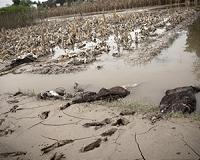 |
Vancouver, Canada (SPX) Feb 08, 2011 University of British Columbia researchers estimate that fisheries catches in the Arctic totaled 950,000 tonnes from 1950 to 2006, almost 75 times the amount reported to the United Nations Food and Agriculture Organization (FAO) during this period. Led by Prof. Daniel Pauly, the research team from UBC's Fisheries Centre and Dept. of Earth and Ocean Sciences reconstructed fisheries catch data from various sources - including limited governmental reports and anthropological records of indigenous population activities - for FAO's Fisheries Statistical Area 18, which covers arctic coastal areas in northern Siberia (Russia), Arctic Alaska (the U.S.) and the Canadian Arctic. The Arctic is one of the last and most extensive ocean wilderness areas in the world. The extent of the sea ice in the region has declined in recent years due to climate change, raising concerns over loss of biodiversity as well as the expansion of industrial fisheries into this area. The details are published in the journal Polar Biology. "Ineffective reporting, due to governance issues and a lack of credible data on small-scale fisheries, has given us a false sense of comfort that the Arctic is still a pristine frontier when it comes to fisheries," says lead author Dirk Zeller, a senior research fellow at UBC's Fisheries Centre. "We now offer a more accurate baseline against which we can monitor changes in fish catches and to inform policy and conservation efforts." Official FAO data on fish catches in Area 18 from 1950 to 2006 were based solely on statistics supplied by Russia and amounted to 12,700 tonnes. The UBC team performed a detailed analysis and found that it's only the tip of iceberg. The team shows that while the U.S. National Marine Fisheries Service's Alaska branch currently reports zero catches to FAO for the Arctic area, the state agency, the Alaska Department of Fish and Game has collected commercial data and undertaken studies on 15 coastal communities in the Alaskan Arctic that rely on fisheries for subsistence. The estimated fish catch during this period in Alaska alone totaled 89,000 tonnes. While no catches were reported to FAO by Canada, the research team shows commercial and small-scale fisheries actually amounted to 94,000 tonnes in catches in the same time span. Meanwhile, Russia's total catch was actually a staggering 770,000 tonnes from 1950 to 2006, or nearly 12,000 tonnes per year. "Our work shows a lack of care by the Canadian, U.S. and Russian governments in trying to understand the food needs and fish catches of northern communities," says Pauly, who leads the Sea Around Us Project at UBC. Researchers from the Sea Around Us Project have previously shown a trend of fish stocks moving towards polar regions due to the effects of climate change. This, coupled with increased accessibility of the Arctic areas due to melting sea ice, will place immense pressure on the region for future large-scale fisheries. "This research confirms that there is already fishing pressure in this region," says Pauly. "The question now is whether we should allow the further expansion of fisheries into the Arctic." "Conservation efforts in the Arctic have so far focused on the exploitation of marine mammals - seals and polar bears are frankly easy on the eye and plain to see," says Zeller. "None of them would survive, however, if we allow over-exploitation of fish in this delicate but so-far neglected ecosystem."
Share This Article With Planet Earth
Related Links University of British Columbia Farming Today - Suppliers and Technology
 Southern Africa floods threaten more crops
Southern Africa floods threaten more cropsRome (AFP) Feb 7, 2011 Floods and heavy rain across southern Africa have damaged thousands of hectares (acres) of farmland and more may be hit in coming weeks, raising fears for food supplies, the UN food agency said Monday. With the rainy season still only half way through, and with the cyclone season due to peak in February, agricultural areas along the region's rivers in remain at high risk of flooding, the Foo ... read more |
|
| The content herein, unless otherwise known to be public domain, are Copyright 1995-2010 - SpaceDaily. AFP and UPI Wire Stories are copyright Agence France-Presse and United Press International. ESA Portal Reports are copyright European Space Agency. All NASA sourced material is public domain. Additional copyrights may apply in whole or part to other bona fide parties. Advertising does not imply endorsement,agreement or approval of any opinions, statements or information provided by SpaceDaily on any Web page published or hosted by SpaceDaily. Privacy Statement |